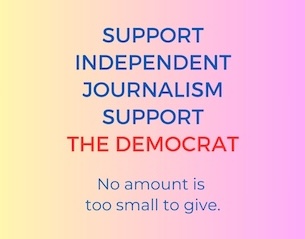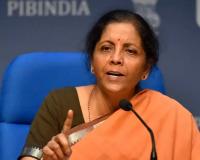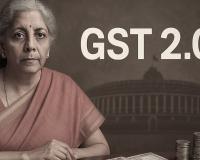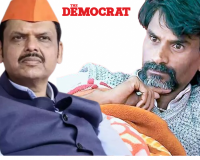- Editorial
- Maharashtra: Theatre of the Absurd with Villains All Around
Maharashtra: Theatre of the Absurd with Villains All Around
It is a theatre of the absurd in Maharashtra politics with villains on all sides and no heroes. It has come down to the last few hours of deadline to form the state government, after nearly two weeks of uncertainty reigning supreme. The BJP won 105 MLAs in the 288-member assembly and Sena, 56. Together
It is a theatre of the absurd in Maharashtra politics with villains on all sides and no heroes. It has come down to the last few hours of deadline to form the state government, after nearly two weeks of uncertainty reigning supreme.
The BJP won 105 MLAs in the 288-member assembly and Sena, 56. Together they are well past the majority mark of 145 but the Sena wants equal partnership claiming that this was a pre-poll deal between the two partners. Actually, Shiv Sena has understood that BJP cannot get power without its support so playing hard ball. Also Sena vote percentage is on the decline over the last few elections. And BJP addresses the same Hindutva constituency as it does. Shiv Sena desperately wants to come out of the BJP’s shadow. This is understandable as the party has traditionally been the big brother in the alliance, until 2014, when the BJP’s sudden rise under Narendra Modi helped it overtake the Sena.
Take a look at the BJP and Sena’s vote share in every Maharashtra Assembly election since 1990. The Sena’s vote share has consistently been in the range of around 16-20 percent in the state. On the other hand, the BJP was at 10.7 percent, that is five percentage points below the Sena in 1990 – mainly because it contested lesser seats – but suddenly rose to 27.8 percent in 2014, when the two parties contested separately. This enabled BJP to have its first ever chief minister in the state in Devendra Fadnavis – relegating Sena to the ‘number two’ status. As a result, in the recent Assembly polls, the Sena had to swallow its pride and contest just 124 seats, 40 less than the BJP. The BJP ended up with a vote share of 25.8 percent, over 9 percentage points more than that of the Sena. Partly because Sena ended up contesting a larger chunk of seats in western Maharashtra – where NCP and Congress are both strong – while the BJP got more seats in Vidarbha, where the Congress has gradually been weakening.
There is an ideological aspect to this as well. Throughout the 1990s and 2000s, the BJP under Atal Bihari Vajpayee was considered the moderate Hindutva party while the Sena under Bal Thackeray was considered the hardline Hindutva party. This helped Sena to dominate BJP in Maharashtra. This changed after the demise of Thackeray in 2012 and the emergence of Modi on the national political scene. For many core Hindutva supporters, Modi was the new ‘Hindu Hriday Samrat’ – a title earlier attributed to Bal Thackeray. With Thackeray dead and charismatic cousin of the successor Uddhav Thackeray, namely Raj Thackeray, out of Sena, it meekly went down in impact and image.
Hence, this is the last time that Sena can take the centre-stage, and more so, with the first time ever electoral battle and victory of a Thackeray scion, Uddhav’s son Aditya Thackeray from Worli. This is not just lust for power for his son, Uddhav knows this is now or never for him and Sena to stay relevant in Maharashtra politics. So Sena needs to be at the centre of power. No justification, but realpolitik for Sena. And is secretly being egged by the willy NCP supremo Sharad Pawar of NCP and the silent unhappy BJP leader Nitin Gadkari, whose 12 proteges were not given tickets leading them to switch sides to NCP.
Sena’s desperation is also due to the fact that after getting clear majority in the centre, BJP has treated its allies with almost a disdain, allowing just one ministerial berth which pissed off both JDU of Nitish Kumar and Shiv Sena. Also, the same fate would have befallen Sena if BJP could have managed a majority on its own or with the easily bought-over support of a few independents in the Mahrashtra elections this time around.
On the other hand BJP has got the taste of its own medicines it used to snatch power in Goa where it did not have majority and was after Congress but tied with anti-BJP party Goa Forward and formed government, or in Manipur or Meghalaya or Nagaland where it tied up-with smaller local parties to deprive the single largest parties to come to power, or in Arunachal & Uttaranchal where it engineered whole-scale defection and used to office of the Governor to assume power, and latest in Karnataka where it first failed to get majority of the floor even after getting power and then engineered rebellion within the ruling JDS-Congress government and forced it to become a minority government. It takes a crook to fix a crook. That’s what is happening in Maharashtra. This time, it is BJP on the back-foot and perhaps for the first time since 2014.
On the other side, though NCP supremo has repeatedly noted that the mandate for them is to sit in the opposition and they are ready to do so, it must be noted that Pawar also had made trips to Delhi and met Sonia Gandhi, NCP had discussions with the Sena man of the moment, Rajya Sabha MP Sanjay Raut, and there are unconfirmed reports of discussions with Gadkari through emissaries. Obviously, NCP is waiting for the single largest party BJP to fail in getting majority if Sena remains belligerent, and thereafter it can open its cards: either being part of the Sena led government or supporting Sena government from outside along with Congress.
Congress has proven to be the dumbest of all in this season of drama, intrigue and political unpredictability. First, it did not at all fight the elections with heart into it accepting defeat even before the first salvo was fired with leaders, national or local, missing in action except in their family bastions. Second, it did not take any political stand in the last two weeks and has chosen to be bystanders. Third, it seems to have no plan ahead except just one thing that it will not be an active part of whichever government comes to power in Maharashtra.
Now going ahead, the Governor is bound to call the single largest party to form govt and prove its majority on the floor of the Assembly. BJP can gain that majority either by breaking Sena or NCP or both; or it may be buoyed by a favourable pro Ramjanmabhoomi verdict expected ahead and force Sena to fall in line. One school of thought is that BJP might be delaying this for two weeks expecting a favourable Supreme Court verdict in the vexed Janmabhoomi issue, and thereafter the party would go ballistic with pro-nationalism pro-Hindutva pro-BJP blitzkrieg forcing Sena to fall in line or risk being called anti-Hindu and anti-national. Sena then might settle for a deputy CM position apart from a few plum ministries. The fact that one alliance partner, Sena, has herded its MLAs in a hotel to protect them from being poached by another alliance partner, BJP, shows to what nadir of Indian politics have we descended to and witnessing now, and how corrupt and immoral is this alliance, led by BJP. In fact, even if either of the solutions noted above happens, the marriage of convenience may not run long.
Or BJP might go for a compromise candidate like Gadkari or his protege Sudheer Mungatiwar as the last option and get Sena on board. This is one remote possibility also to keep BJP at the driver’s seat though it is unlikely that the shrewd Brahmin, Devendra Fadnavis, will so easily let go his power.
Alternatively another farce like in other states can happen with Sena coming to power with NCP, and Congress supporting from outside if BJP fails to prove majority, as we saw in Karnataka when Yeddy failed and the unlikely govt of Cong-JDS was formed. In any case, people lose and democracy retreats in any of the cases noted above.
It must be noted that if the single largest party fails to prove its majority, the Governor is duty bound to call the next party, Sena in this case, more so if it can submit list of supporting MLAs and even parade them before the Governor. If this option fails, it is a breakdown of constitutional machinery leading President’s rule as per Article 356 of the Indian constitution which can be continued in normal circumstances for a maximum of six months (extension allowed).
The author is currently the Pro Vice Chancellor of Kolkata based Adamas University, and a regular columnist and television analyst, being the former Media Dean of Symbiosis, Amity, Pearl Academy and Whistling Woods International.













